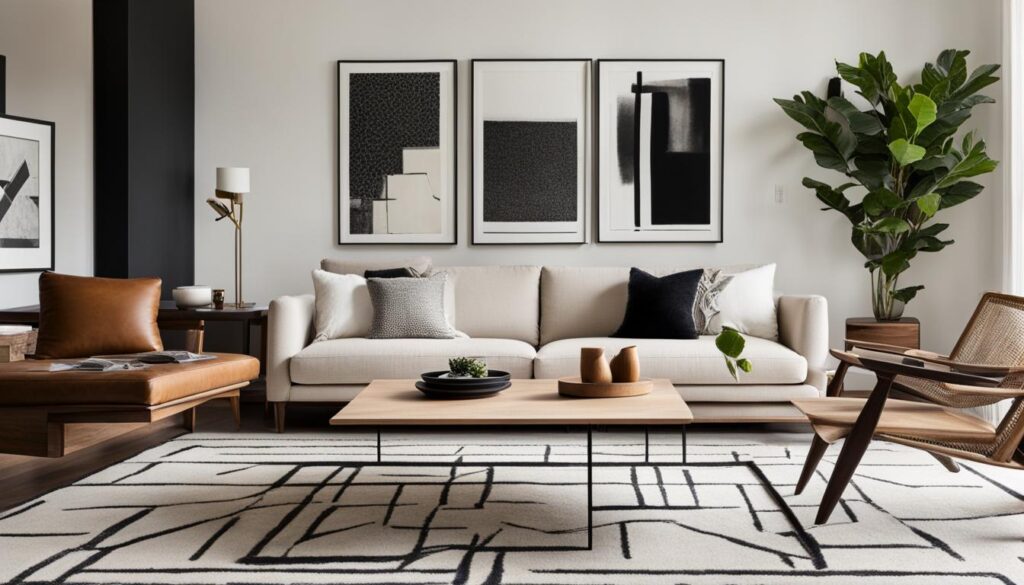As someone who loves to refresh my space, I’ve come to discover that furniture rearranging is more than a weekend DIY project. It’s a transformative process that serves not only to renew the visuals of my home but also to amplify its comfort and functionality. Whether it’s a cozy nook or a sprawling living room, I believe with a few strategic moves we can all craft environments that beckon joy into every corner—no matter the size. Let’s dive into the nitty-gritty of furniture rearrangement, and I’ll show you how assessing different layout examples and tricks can effectively fine-tune the purpose and feel of your diverse living spaces.
For me, DIY furniture rearranging is like a puzzle; every piece has a place where it fits just right. By flipping the script in room furniture rearrangement, not only do I liven up my home’s look, but I also forge a path to new-found functionality, creating an abode that answers perfectly to my day-to-day life. Let’s unlock the full potential of your rooms together, with hands-on tips and inspired ideas.
Key Takeaways
- Unlocking aesthetic and functional potential through furniture rearranging.
- Tailoring rearrangement strategies to accommodate any room size.
- DIY tips for a personalized and practical room transformation.
- The value of assessing multiple layouts for optimized living spaces.
- Creating purposeful and inviting environments with smart furniture placement.
- Maximizing comfort and room usability through strategic rearrangement.
The Impact of Furniture Rearranging on Your Home’s Aesthetics and Functionality
Transforming the look and feel of your home can be as simple as implementing a few furniture arrangement tips. When I begin the process of rearranging, it’s not just about pushing furniture around; it’s a methodical approach that enhances both the aesthetics and functionality of my living space. Let’s discover how to effectively utilize furniture placement ideas for a more spacious and inviting home.
Finding Your Room’s Purpose and Enhancing It Through Arrangement
Identifying the primary function of a room is crucial in furniture rearranging for small spaces. For example, a living room’s purpose of gathering and entertainment will dictate a setup conducive to conversation and comfort. Here, the couch in the middle of the room can serve as an inviting centerpiece, drawing guests in for a chat.
Creating a Focal Point with Furniture Arrangement
Every room needs a focal point, be it a fireplace, television, or a stunning art piece. This serves as an anchor around which all other furniture should be arranged. In the case of a bedroom or dining area where a natural focal point may not be obvious, the bed or dining table can take center stage, thus defining the room’s layout.
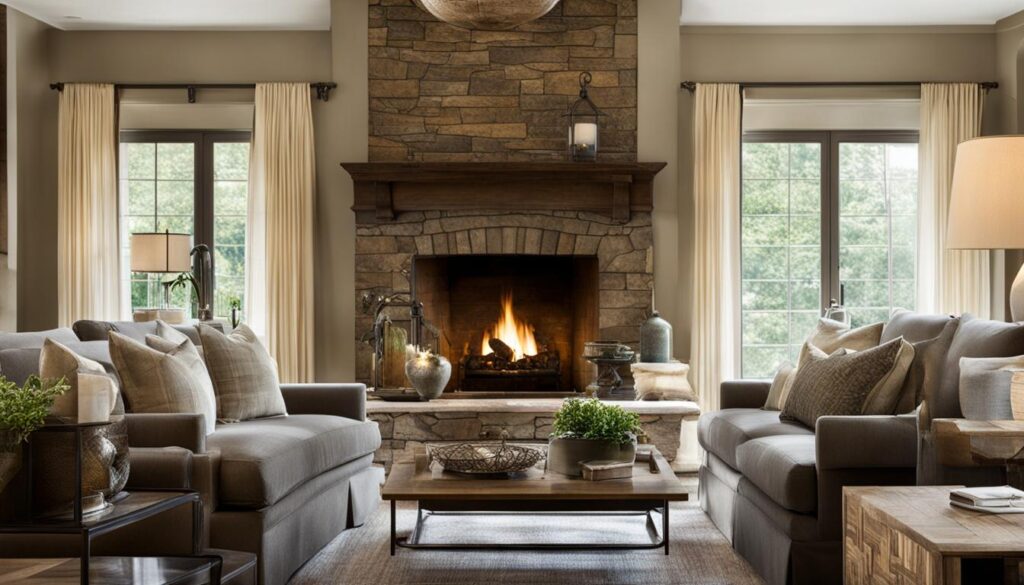

Strategic Furniture Placement for Improved Traffic Flow
The goal of space-saving furniture arrangement is not only to make a room look larger but also to ensure effortless movement within the space. Techniques like placing the couch in middle of living room can open up walkways, whereas strategic furniture layout techniques can foster a clutter-free atmosphere. Always remember to leave adequate space for a comfortable traffic flow around the furniture.
- Aim for at least 30 inches of walkway space around furniture.
- Keep a distance of 14-18 inches between coffee tables and sofas.
By applying these principles, I’ve found that my home feels more cohesive, looks well put-together, and functions with ease for daily living.
Furniture Layout Techniques: A Guide to Optimal Placement
As someone who’s passionate about home décor, I’ve learned that the key to creating a space that feels both open and inviting lies in mastering furniture layout techniques. Angling furniture in a corner or placing your sofa in the middle of the room can transform the ambiance of your living space. It’s not just about making a statement—it’s about crafting a room that’s both functional and beautiful.
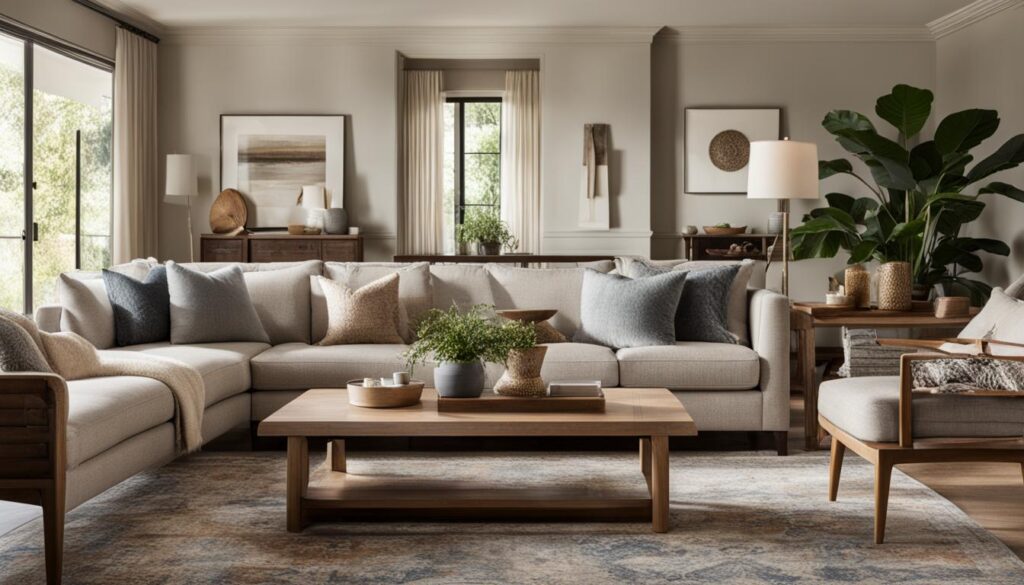

Here are some principles I swear by for achieving that sweet spot of aesthetic appeal and space optimization:
- **Entryways** – Leave enough space for a welcoming drop-off spot. It’s not just about a good first impression but also functionality for stowing away shoes and coats.
- **Furniture Float** – Don’t be afraid to float your sofa away from the walls. This technique can actually give the illusion of more space and create a cozy, intimate seating area.
- **Cohesion and Scale** – Choose coffee tables and side tables that harmonize with the size of your sofa and chairs. It’s all about proportion for comfort and flow.
So next time you’re considering a room refresh, think about angling a statement chair in a corner or anchoring the space with a sofa in the middle of the room. These simple shifts can make a world of difference in your home’s layout, leading to a functional and inviting environment.
Furniture Rearranging Hacks For Every Room Type
As I dive into the art of home refinement, I’ve uncovered some effective strategies to alleviate the common problem of too much furniture in a room. My experiments with space-saving furniture arrangement have not only maximized my rooms’ potential but also enhanced their overall charm and functionality. Let me share some tips that have personally transformed my living spaces.
Livening Up Living Rooms with Strategic Seating
My living room once felt cramped, a clear victim of too much furniture in living room syndrome. The game-changer? Repositioning the sofa in middle of living room to serve as an inviting centerpiece for social gatherings. By creating multiple conversation areas, each nook of the room turned into a warm, interactive space, free from the cluttered feeling it had before.
Transforming Bedrooms with Bed Placement and Accessorizing
My quest for tranquility led me to tackle the issue of too much furniture in bedroom. By situating the bed towards the serenity of a window and thoughtfully accessorizing with nightstands and benches, the bedroom regained its purpose as a sanctuary for rest. Clearing the clutter introduced harmony that’s boosted my sleep quality tenfold.
Reenergizing Dining Spaces with Table Shapes and Arrangement
The dining room was another story. Previously, it felt more like a furniture warehouse with too much furniture in dining room. Selecting a round table to complement the room’s intimacy sparked a fresh dynamic for family meals. This, along with judiciously chosen seating, has made dinner time the highlight of our day.
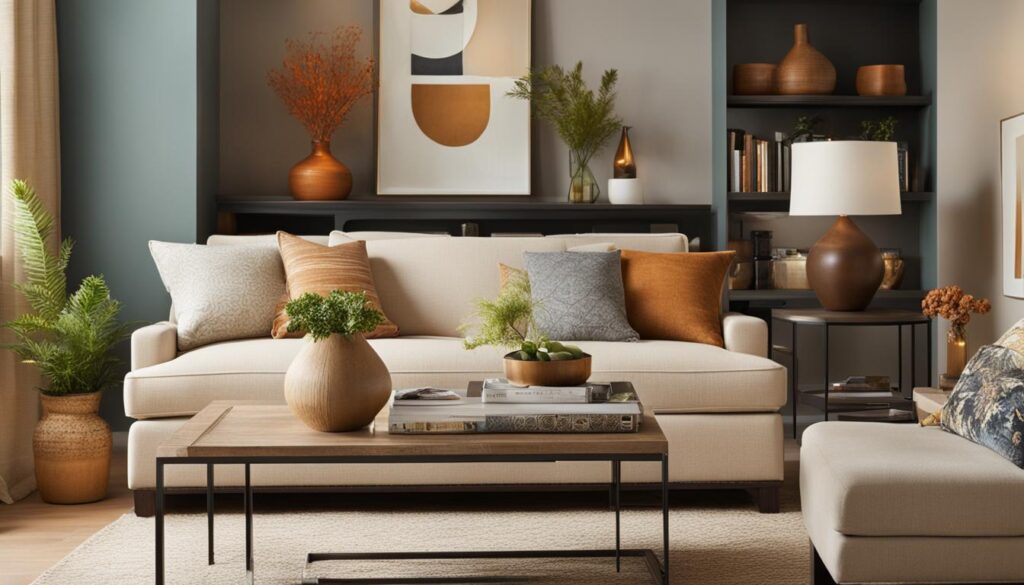

How to Utilize Space-Saving Furniture Arrangement
Dealing with too much furniture in a small bedroom or living room can be quite a challenge. I’ve found that the art of furniture rearranging for small spaces is an effective solution to maximize the limited square footage without sacrificing style or comfort. I’m excited to share some furniture rearranging hacks and decluttering strategies that have transformed my compact living quarters into an organized, spacious haven. Let’s dive into the techniques that can help you create a more open and functional environment.
Selecting and Positioning Furniture for Small Bedrooms and Living Rooms
Selecting the right furniture for small spaces is a critical first step. I prioritize pieces that are scaled down to fit the proportions of the room. After picking out smaller furniture, it’s essential to strategically position them, ensuring enough walkable space is maintained between them. This not only creates the illusion of more space but also facilitates ease of movement.
Employing Vertical Storage and Multipurpose Pieces
The use of vertical space is a game-changer. By opting for tall, slim-profile furniture items like armoires or floating shelves, I take advantage of the often underutilized wall space. Multipurpose pieces such as nesting tables and storage ottomans also play a key role in reducing clutter; they serve more than one function while tucking away neatly when not in use.
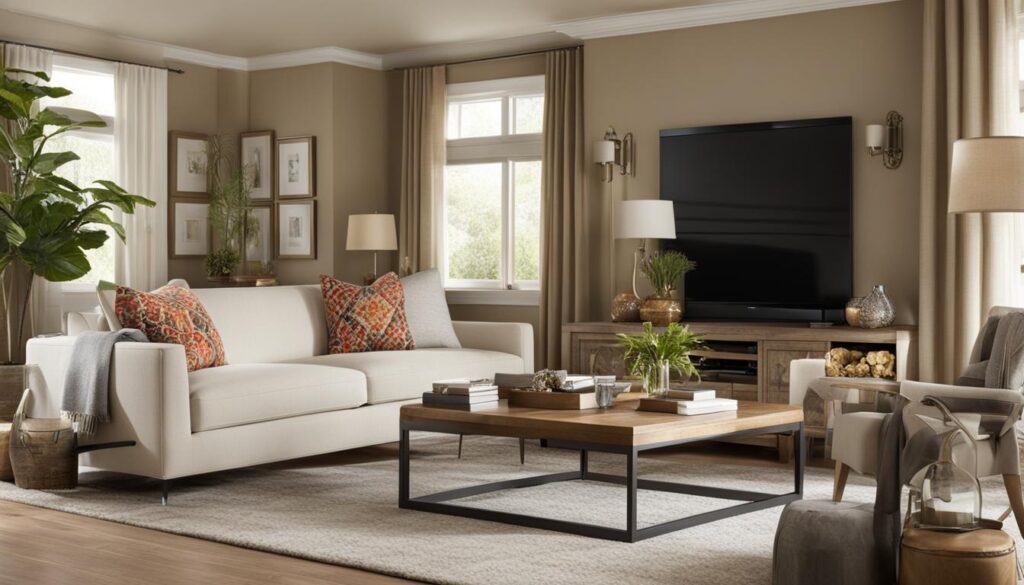

Decluttering Techniques to Maximize Space Utilization
Decluttering is more than just a buzzword; it’s an essential practice in managing small spaces. It involves making conscious choices about which furniture pieces to keep and where they should be placed. By eliminating what is unnecessary and organizing what remains, my bedroom and living room have become emblematic of space efficiency.
- Assess each piece of furniture for its function and necessity.
- Implement storage solutions that double as decorative pieces.
- Rearrange the room layout periodically to prevent a stale atmosphere.
These furniture arrangement tips not only expanded the visual dynamic of my rooms but also enhanced the overall functionality. Remember, with a bit of creativity and an eye for design, even the smallest spaces can become your favorite places.
Determining the Ideal Furniture Arrangement with Feng Shui Principles
When I look to infuse peace and positive energy into my home, I delve into the ancient art of Feng Shui. It’s a thoughtful approach to furniture rearrangement that goes beyond mere aesthetics or practicality. Feng Shui tells us our living spaces are a mirror of what’s happening inside us. Aligning my environment with these principles has been a transformative experience that’s surprisingly in line with the latest furniture rearranging hacks I’ve come to love.
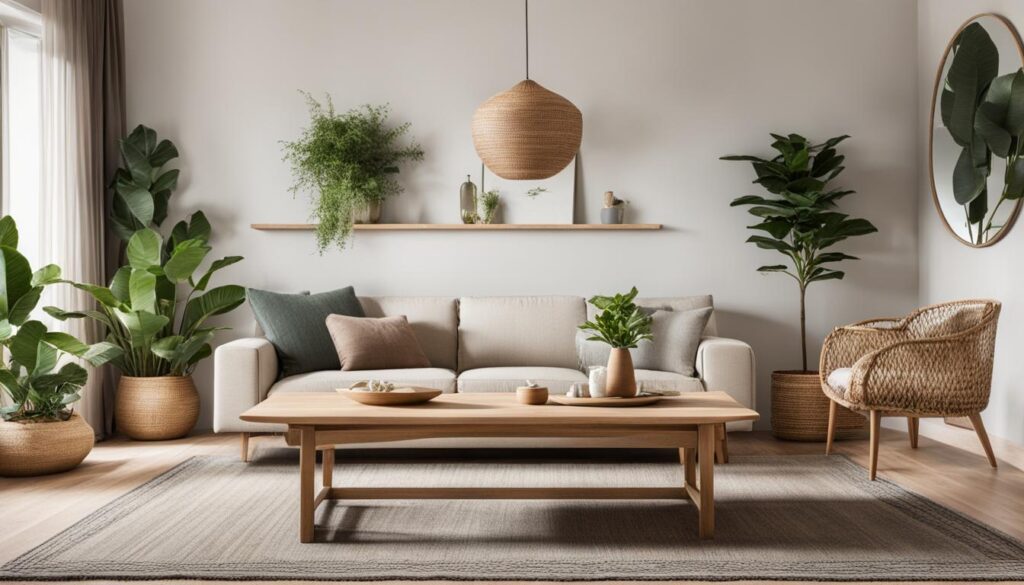

One fundamental concept in Feng Shui is the commanding position. It involves placing the key furniture pieces so they face the main door, yet are not in direct line with it. This position commands the space and symbolizes an open approach to life’s opportunities. Be it my bed, my favorite armchair, or my desk, ensuring they have a clear view of the door has brought a subtle shift in how connected and protected I feel in my own space.
- Identify the room’s purpose and the corresponding Bagua area
- Implement elements that nourish the chi energy of that space
- Ensure furniture does not block windows or doorways to promote smooth chi flow
In practice, this philosophy means I might position my sofa in the living room so it’s facing the door but off to one side — not only does it make the room more inviting, it makes for a better conversational grouping too.
- Use mirrors to expand the sense of space and reflect light
- Choose rounded furniture to encourage a gentle flow of energy
- Incorporate plants to harness the wood element for growth and vitality
As I align my home with these principles, the furniture rearrangement becomes not just about functionality or design, but rather a meaningful process of ensuring my environment reflects a balanced, harmonious lifestyle. And with each shift, each relocation of a piece of furniture, it’s as if the energy of the room is recalibrated, priming my home as a sanctuary for inspiration and tranquility.
Empowering Your Space Through Impactful Furniture Rearrangement
As we’ve explored the transformative potential of furniture rearranging, it’s clear that the right positioning can not only refresh a home’s look but enhance every aspect of its use. I’ve shared how introducing a couch in the middle of a room can redefine your living space, fostering a convivial atmosphere for love and laughter. Finding the sweet spot for each piece, from the bedroom to the dining area, is not just about filling space—it’s about creating room for life to unfold in the most harmonious way.
Mindful furniture rearrangement is a powerful tool, enabling us to craft an environment that’s both aesthetically pleasing and supremely functional. Whether it’s maximizing space in a cozy apartment or orchestrating an inviting layout in a spacious home, the strategic choice of where to place each item holds the key to unlocking the full potential of our personal havens. An impactful furniture rearrangement goes beyond mere aesthetics—it supports our daily activities, energizes our living space, and turns our homes into sanctuaries.
In conclusion, my journey with you through the art of furniture arrangement has underscored the pivotal role it plays in curating a lifestyle that sparks joy and ease. By honoring the innate purpose of each room, establishing dynamic focal points, and preserving a seamless traffic flow, we craft not just spaces but experiences—a testament to the profound impact of thoughtfully curated interiors on our daily existence. In every adjustment and shift, remember that the ultimate aim is a setting where your comfort and happiness are in perfect harmony—a place you are proud to call home.
FAQ
How do I determine the best layout for my furniture to enhance both aesthetics and functionality?
To determine the best layout for your furniture, consider the room’s purpose, create a focal point, and arrange your furniture to improve traffic flow. Strategic placement is key, such as floating furniture away from walls and choosing appropriately scaled items for your space.
What if I have too much furniture in my living room or bedroom?
If you have too much furniture, analyze what pieces are essential for the room’s functionality. Consider donating or selling items that clutter the space. For critical pieces, think about repositioning them to optimize space and traffic flow. Using multipurpose furniture can also help reduce the amount of furniture needed.
Can placing a couch in the middle of a room work in any living room layout?
Yes, placing a couch in the middle of the room can work as a powerful focal point or to define different areas within a large space. Ensure there’s adequate space around it for traffic flow, and complement it with other seating to create an inviting conversation area.
What are some furniture arranging hacks for small spaces?
Furniture arranging hacks for small spaces include employing vertical storage, choosing multipurpose or foldable pieces, and ensuring furniture scale matches room size. Keeping pathways clear and using lighter colors for large items can also make the room feel more spacious.
How do I apply Feng Shui principles while rearranging furniture?
Apply Feng Shui principles by identifying the commanding position for key pieces of furniture like a bed or desk, ensuring clear pathways for Qi (energy) flow, and using the Bagua map to place furniture and objects in a way that corresponds and nurtures the area’s life aspects.
Are there any specific tips for angling furniture in a corner?
When angling furniture in a corner, make sure it doesn’t block natural pathways and complements the room’s overall layout. It can create a cozy nook for reading or conversation, and balance the room’s visual weight if used with other angled or rounded pieces across the space for harmony.
What strategies can I use to declutter my room during a furniture rearrangement?
To declutter during a furniture rearrangement, start by removing items that are no longer needed or do not serve the room’s purpose. Use storage furniture that conceals items, such as ottomans with storage, and regularly reevaluate what items are essential for keeping the space organized and functional.
How can I make my small bedroom feel larger with furniture arrangement?
To make a small bedroom feel larger, choose furniture with a smaller footprint or pieces that can be folded away when not in use. Place the bed in a position where it doesn’t obstruct the doorway and use mirrors to create an illusion of more space. Opt for storage solutions that use vertical space effectively.
What’s the importance of creating a focal point with furniture arrangement?
Creating a focal point with furniture arrangement is vital for drawing the eye and anchoring the room. It provides a central point around which to organize the other pieces, such as a fireplace, artwork, or a large window, and helps to define the room’s intended use and atmosphere.

